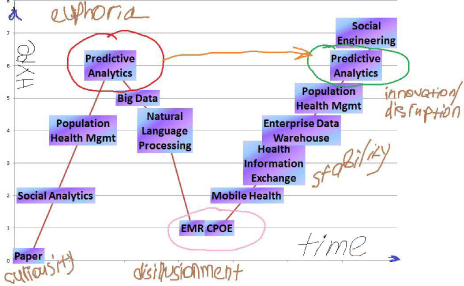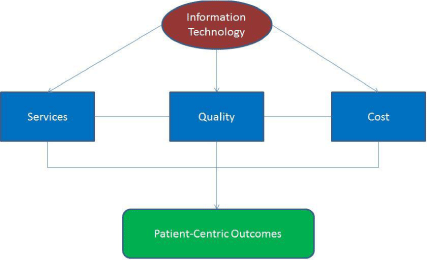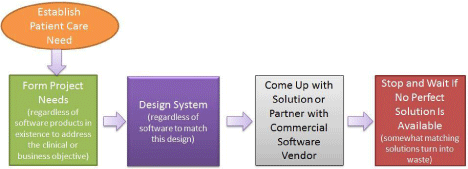
Editorial
Austin J Comput Biol Bioinform. 2014;1(2): 2.
Health Infonomics: The Changing Landscape of Health Information Technology (HIT) and the Factors Driving HIT Investment and Measurement
Krive J1,2,3*
1Department of Biomedical and Health Information Sciences, University of Illinois at Chicago, USA
2Department of Biomedical Informatics, Nova Southeastern University, USA
3Department of Information Systems, Advocate Health Care, USA
*Corresponding author: Krive J, Department of Biomedical and Health Information Sciences, University of Illinois, 1919 W. Taylor Street, Chicago, IL 60612, USA
Received: September 11, 2014; Accepted: September 25, 2014; Published: September 30, 2014
As a relatively young niche of information technology in the process of maturation, HIT has already gone through several stages of (first) chaotic and (later) systematic government-encouraged development. Early skepticism regarding benefits of the digitization of medical records and computer-assisted clinical workflow turned into excitement regarding HIT's ability to drive healthcare quality improvement efforts resulting from electronic medical records (EMR) installations and streamlining ordering process via computerized physician order entry (CPOE) applications. Large metropolitan healthcare systems championed HIT investment: the rate of adoption was closely associated with large size, urban location, and health maintenance organizations (HMO) penetration [1]. Early documented and perceived gains from EMR and CPOE in the processes of clinical workflow enhancement, quality improvement, and reduction of medical errors, led to further development of disciplines that relied on the marriage of information and medical sciences - "big data" analytics, population health, clinical decision support systems (CDSS), natural language processing, mobile health, health information exchange (HIE), and even social engineering. EMR adoption was systematized and documented in several widely accepted models, such as HIMSS EMR Adoption Model [2] and the Meaningful Use provision of the Accountable Care Act, the latter one ensuring interoperability of disparate HIT applications.
HIT development has gone through stages of a typical hype circle, from curiosity regarding early electronic medical record ideas to euphoria about the future potential of HIT, to disillusionment about ability of HIT to transform healthcare delivery via EMR and CPOE inventions, to a steady build-up of technologies that use EMR as a basis for advancement (Figure 1). As HIT travels through the hype circle, and billions of dollars are invested into it, fueled by US government mandates, it becomes apparent that the HIT outcomes measurement process needs to be centered around clinical outcomes, especially in the absence of real productivity gains [3] expected of initial technology investments. While technologies such as CDSS have demonstrated success in driving effectiveness of specific process measures [4], HIT research remains in the early stage of demonstrating measurable clinical impact [5]. It becomes clear that technology by itself will not positively impact safety. Instead, technology supported clinical workflow changes could hold the biggest promise of making measurable impact on quality and safety of patient care [6]. Massive and frequently chaotic investment in HIT needs to be replaced by targeted clinical problem definition that begins the process of technology investment [7], followed by ensuring routinization - the process by which using innovation becomes regular organizational practice [8].
Figure 1: HIT hype curve.
Biomedical informatics research of health outcomes resulting from information technology development has remained separate from "field" investments at hospitals and medical practices that were largely driven by government spending and perceived expectations of quality and productivity gains. As healthcare cost pressures rise and healthcare delivery model shifts from volume to value based reimbursement, the need for a new niche of health economics - health informatics economics, or "health infonomics" - becomes apparent. Health infonomics science would merge biomedical informatics research with health economics and HIT investment mechanisms to generate new models of targeted selection and measurement of information technology aimed at reaching specific clinical and/or productivity goals.
Changes in perception, evaluation, and measurement of the effectiveness of healthcare information systems are likely to lead a change in expectations and assessment of IT operations in healthcare organizations. Three traditional measures of IT effectiveness - service, quality, and cost - will be tied to patient-centric outcomes (Figure 2). This structure mimics industry service model change from physician-centric to patient-centric processes aimed at delivering accessible high-quality care. In accordance with this patient care impact measure, future HIT investment, as well as operational effectiveness and customer satisfaction, will require a new inclusive measure of success represented by a combination of clinical, technology, and cost factors (Figure 3). Patient Care Index, aimed at measuring the overall effectiveness of HIT investment and operations, would link technology to patient outcomes, removing separation between technology acquisition and enterprise clinical goals of the healthcare organizations. Such fundamental shift to tying success of information technology to clinical outcomes would drive re-evaluation of existing return on technology investment models to tie them to core clinical and cost objectives of healthcare organizations. The patient care index is a composite statistical score that includes a multitude of factors ranging from clinical outcomes, directly linked to specific technologies, to operational effectiveness in terms of systems stability and availability to customer satisfaction scores.
Figure 2: Patient-centeric HIT assessment.
Figure 3: Tying core HIT assessment factors to core objectives of the healthcare organizations.
Project management and selection of computer applications to meet the needs of a clinical enterprise would undergo changes in accordance with health outcomes orientation of the technology selection process. Instead of identifying technological needs and subsequently evaluating technology's potential to bring desired benefits to the organization, the process would reverse to identification of specific clinical problem - leading to a technology solution (Figure 4). If no closely matching solution is identified, a recommendation should be made to stop and reevaluate software market opportunities, perhaps at a later time, due to lack of a sizable impact on patient outcomes and patient care index score - the core measurement instrument for the HIT effectiveness. Or this could be an opportunity for a breakthrough innovation to develop a new software market and/ or patient services segment of health informatics.
Figure 4: Patient care centric HIT software selection model.
Reevaluation of HIT goals, expectations, and measurement processes would initiate changes in the healthcare software market, as well as investment allocation processes at the provider organizations. Ultimately, providers, patients, and suppliers are expected to benefit due to renewed focus on patient care quality and targeted healthcare technology spending. Health infonomics, as a way to discover new models of assessing feasibility and impact of HIT investments while targeting core clinical objectives of the healthcare organizations, is a new instrument for bridging the gap between biomedical informatics and health information technology advancements, as applicable to the business of clinical enterprises.
References
- Zhang NJ, Seblega B, Wan T, Unruh L, Agiro A, Miao L, et al. Health information technology adoption in U.S. acute care hospitals. J Med Syst. 2013; 37: 9907.
- HIMSS Analytics United States EMR Adoption Model. Chicago: HIMSS. 2014.
- Lee J, McCullough JS, Town RJ. The impact of health information technology on hospital productivity. Rand J Econ. 2013; 44: 545-568.
- Murphy EV. Clinical decision support: effectiveness in improving quality processes and clinical outcomes and factors that may influence success. Yale J Biol Med. 2014; 87: 187-197.
- El-Kareh R, Hasan O, Schiff GD. Use of health information technology to reduce diagnostic errors. BMJ Qual Saf. 2013; 22 Suppl 2: ii40-40ii51.
- Aarts J. A sociotechnical perspective of health information technology. Int J Med Inform. 2013; 82: 1133-1135.
- Cresswell KM, Bates DW, Sheikh A. Ten key considerations for the successful implementation and adoption of large-scale health information technology. J Am Med Inform Assoc. 2013; 20: e9-9e13.
- Cresswell K, Sheikh A. Organizational issues in the implementation and adoption of health information technology innovations: an interpretative review. Int J Med Inform. 2013; 82: e73-86.



